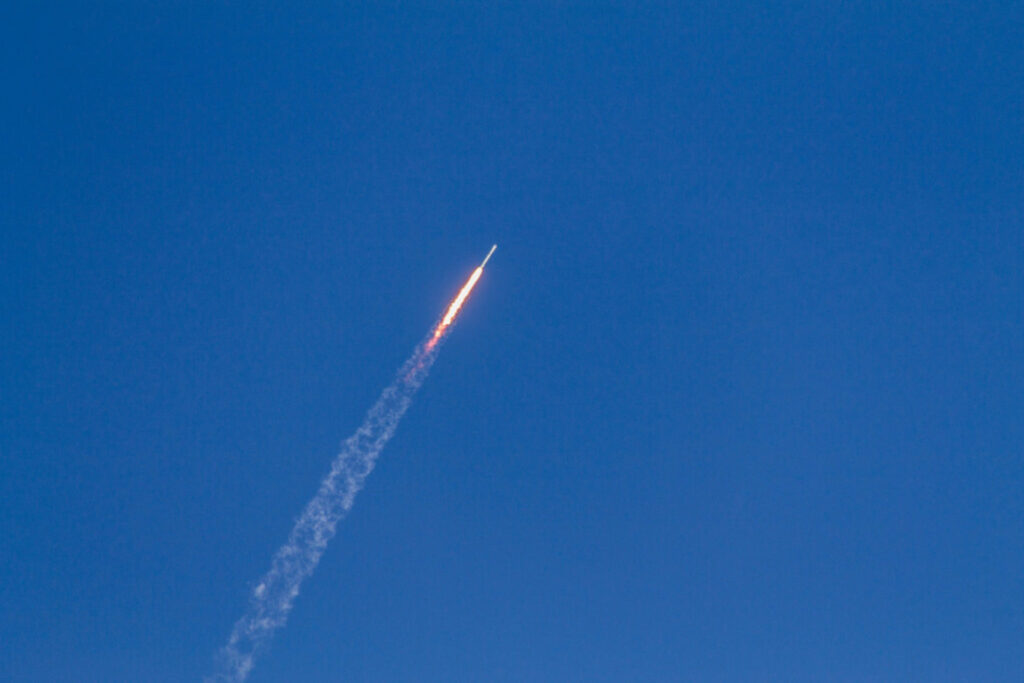Space Launch Vehicles (SLVs) are gaining prominence, even among developing states, as a means of exerting greater influence and leverage in space. These technologies not only add to a state’s technological prowess, contributing to its power and prestige, but also enable states to explore and exploit space for their own benefit, whether for peaceful and commercial purposes or for launching military satellites into space.
However, such technologies could also be used to develop ballistic missile capabilities. Many states are progressing with SLV technologies, raising concerns about their potential military applications. Although legal frameworks exist, these can only be enforced on states that are parties to these legal paradigms. This article examines the nuances of SLV technologies developed by states, as well as the existential legal and tangible complexities of their military applications. The article studies states that have advanced these technologies and the legal frameworks currently in place to resolve these security imperatives. Additionally, the article studies the loopholes in these legal mechanisms that provide leeway for states to venture into military applications of space-based technologies like SLVs.
Technological Challenges of SLVs
Both space and ballistic missile programs are integral to a state’s ability to demonstrate its technological prowess, which, in turn, strengthens its global prestige. This is especially true for states developing liquid-fueled ballistic missiles, as SLVs also use cryogenic rocket propellants like liquid hydrogen, liquid oxygen, and liquid methane for their upper stage. SLVs are carriers that transport satellites into space, just like warheads are carried by ballistic missiles to designated targets. The technological relationship cuts both ways: states like China have applied ballistic missile technology—acquired from the Soviet Union—to their SLV program, while states such as India have converted their SLV program into ballistic missiles. This is precisely why states could choose to refrain from supporting other states’ SLV programs, as slowing down an SLV program could also delay the development of ballistic missiles and curb proliferation.
In fact, with technological advancements in ballistic missile programs of states, states have made technological leaps in missile program. For instance, with technological sophistication, China has progressed “far beyond that technology through its own efforts, and foreign assistance has been limited.” Nevertheless, the fact that the initial program commenced with ballistic missile technology application is noteworthy, as today China progresses towards earning a greater share in the global commercial space systems market. Today, China stands as one of the leading space powers in the world. China’s solid-fueled launcher, the Kaituozhe is based on China’s DF-21 solid-fuel ballistic missile while their liquid fueled launcher, the Chang Zheng 1 (Long March), was based on Chinese DF-4 liquid-fueled ballistic missile that could reach the United States.
The advanced DF-5 intercontinental ballistic missile (ICBM) technology has been utilized to develop the Chang Zheng 2A and Chang Zheng 2C. Other rockets including the Chang Zheng 3—a three-stage launcher—and the smaller Chang Zheng 4A rocket, also borrowed from the DF-5. China now sees to further advance its SLV program, as they test the Chang Zheng 9 while also developing the Chang Zheng 10 and more advanced versions.
On the other hand, states have leveraged SLV technologies for missile development rather than investing separately in missile development programs from scratch. While the concern of proliferation remains with SLVs, both horizontal and vertical proliferation, one argument in favor of such proliferation could be that a state that can utilize its SLV capability to develop ballistic missiles could prevent the possible proliferation of technologies from other states for its own missile development program by focusing on its own existing technologies to develop the same. This means vertical proliferation of one technology to develop another form of technology within the state could prevent the state from engaging in horizontal proliferation.
India’s ballistic missile program under the Integrated Guided Missile Development Program (IGMDP) has its roots in its space technology program. Its Agni category missiles that form the backbone of its nuclear deterrence, has a solid-fueled first stage from SLV-3. In fact, when India was working on intercontinental range ballistic missile capability under its Surya program, there were reports that the Polar Space Launch Vehicle (PSLV)’s solid-fueled rockets would be derived for such missile developments. This is a stark difference from China’s ballistic missile and space program. SLVs are being applied not only for developing ballistic missiles but also for developing countermeasures against adversaries’ missile defense capabilities. Advanced technologies, like multiple independently targetable reentry vehicles (MIRVs), maneuverable re-entry vehicles (MaRVs), and hypersonic glide vehicles (HGVs), on these ballistic missiles, make deterrence a complex equation by adding more burdens on adversaries’ missile defense capabilities. In fact, China has used its Long March-2C Space Launch Vehicle to send HGVs into low orbit and has also combined Fractional Orbit Bombardment System (FOBS) technology with HGVs to evade enemy missile defense systems. Such developments complicate the “deterrence by denial” strategy of adversaries.
Moreover, space-based capabilities not only have their relevance in civil and commercial purposes but also in military paradigms. Such capabilities are used to strengthen command, control, communications, computers, information, intelligence, surveillance, and reconnaissance systems (C4I2SR). To counter these space assets, ballistic missile capabilities have also been viewed as technologies that could be used as anti-satellite (ASAT) weapons that could destroy enemy satellites in space. Yet, these weapons also add to strategic instability owing to the weaponization of space.
For these reasons, the advancement of space technology programs in Iran and North Korea, particularly their development of SLVs, triggered widespread global concerns due to the potential military applications of these technologies. For Iran, many scholars and policymakers believe that its space technology program is a cover for the development of long-range ballistic missile capabilities like the ICBM capability that can reach targets beyond the range of 5,500 km. Iran has used Qased rockets to launch Noor satellites into space. In 2016, according to reports, Iran “successfully orbited satellites using its ICBM-class booster.”
In fact, reports also confirm that Iran’s space program, which slowed down during former president Hassan Rouhani, has picked up pace under the current president, Ebrahim Raisi. Though Iran’s space program is under civilian surveillance, that is, Iranian Space Agency, under the Ministry of Information and Communication Technology, the Ministry of Defense and Armed Forces both play a crucial role in Iran’s civilian space program while the Islamic Revolutionary Guard Corps (IRGC) maintains its own space program.
According to critics, such developments in space technology violate United Nations Security Council Resolution (UNSCR) 2231, which prohibits Iran from developing ballistic missile capabilities. The general assumption is that SLV technologies cut short the state’s journey to acquiring ICBM capability, as both capabilities require similar technologies. In fact, the newer SLV technology uses solid-propellant rocket motors, lightweight carbon casing, and movable nozzles for thrust vector control.
Iran’s use of mobile launchers rather than static launchers by SLVs like those in Qased SLVs makes these concerns more grievous. In fact, the Simorgh is reported to be using hypergolic propellant which is a liquid propellant that can be stored more easily and hence, militarily more conducive than the cryogenic materials used in SLVs. Such propellants have been used in ICBM capabilities namely in the US Titan II ICBM. Storable propellants are always a choice for states possessing land-based ICBM capabilities as such capabilities strengthen deterrence. Although mobile launchers could be developed to make SLVs survivable even during crisis situations, critics argue that this mobility and survivability is intended for reducing the vulnerability of ballistic missiles from attacks by adversaries.
North Korea has similarly faced criticisms for applying ballistic missile technologies to its space program violating UN Security Council Resolutions 1718 and 1874. Reports confirm that the Chollima-1 SLV “shares critical technologies with an ICBM” and, when equipped with warheads and reentry vehicles, could act as deterrence against its adversaries. It is assumed that the Chollima-1 testing is a disguise for testing the technological parameters of Hwasong-15 and Hwasong-17 ballistic missiles. North Korean SLV testing raised concerns about a possible advancement in missile development technologies that could be detrimental to the strategic stability of the Korean Peninsula and detrimental to international security.
North Korea is also working on space-based surveillance systems, and in 2023, it successfully launched the Malligyong-1 satellite, which Pyongyang believes will strengthen its preparedness for war. However, the event invited criticisms from the United States on the grounds that such technologies could be used to develop ICBM capabilities.
The expansion of space activities have raised similar dual-use concerns in other countries, such as Japan, which possesses advanced space technologies like the Epsilon satellite launcher. While Japan does not possess ICBM capabilities as it is prohibited in Article 9 of its Constitution, experts have nonetheless point out that Japan’s solid-propulsion system, which shorten pre-launch time, make it ideal to be converted into ICBM.
Legal Paradigms
The Missile Technology Control Regime (MTCR) has provisions to curtail space launch vehicles and their proliferation that could lead to the development of missile technologies.
However, the regime is not designed to prevent national space programs, which states could potentially use in the near future for advancing SLV program and missile development programs. MTCR partners are also required to be careful of technological advancements and transfers.
Despite the provisions, the MTCR is a regime and not a formal legal mechanism or treaty. States participating in such regimes may oblige to proliferation restrictions on ballistic missiles but may not oblige to such restrictions on space launch capabilities. Many states may want to exploit the space technologies of other states to launch their satellites at inexpensive costs. Again, MTCR restrictions could be eased for different states on considerations of various geopolitical and geostrategic goals.
Nevertheless, the MTCR’s efforts to ensure states provide prior notice of their ballistic missile launches, space launch vehicles, and specific information on such capabilities that are being developed are noteworthy. Also, in the case of Argentina’s and Brazil’s missile development programs, which progressed from their space program, the MTCR played a crucial role in preventing the development of missile capabilities with the West by refusing to provide related technologies to the two states.
Those states that subscribe to the Hague Code of Conduct (HCoC), an organization to strengthen transparency and confidence-building measures regarding the missile capabilities of states, are also expected to ratify and accede to the 1967 Outer Space Treaty (OST). However, if states have acceded to the OST but not HCoC or MTCR, they could continue to develop ballistic missiles, as the OST does not include ballistic missiles under its space weapons ban. In fact, in the OST, the issue of A-SAT weapons and missile defense systems remain a big concern.
The HCoC also includes a declaration regarding SLVs including transparency building information that cover “policies, land (test) launch sites, as well as number and general class of space launch vehicle missions conducted in the previous year consistent with pre-launch notifications.”
Article 2f of the HCoC addresses the issues of SLVs recognizing that “states should not be excluded from utilizing the benefits of space for peaceful purposes, but that, in reaping such benefits and in conducting related cooperation, they must not contribute to the proliferation of Ballistic Missiles capable of delivering weapons of mass destruction.” Article 2g further strengthens security by adding that SLVs should not be used as a disguise to conceal ballistic missile development programs.
As the HCoC supplements the MTCR, membership in both regimes could make SLV and ballistic missile development more transparent. However, although the HCoC ensures transparency, it lacks a verifiable body to ensure that the transparency measures are fair and just. It depends on the goodwill of states and their word of mouth. Such transparency could be affected by trust deficit between states. Russia, for instance, accused the United States of not submitting pre-launch notifications of its ballistic missile program. Such trust deficit between states that delve into SLV technology, and could resort to ballistic missile capabilities, could make these Codes of Conduct a farce. Nevertheless, the success of preventing missile development in the Latin American region could also be credited to HCoC.
Such mechanism that obligates states to pre-notify missile tests and SLVs, to avoid confusion and apprehension, strengthen the transparency mechanism, making SLV deterrence credible. The author describes SLV deterrence as the situation where states possessing SLV capabilities that could lead to ballistic missile development are lowering the threshold of deterrence. However, effective mechanisms that check these developments strengthen deterrence by making it cumbersome for states to resort to military uses of space-based capabilities.
In fact, the HCoC could contribute positively if states become members by providing assistance to states pursuing SLV technology in a way that prevents the development of ballistic missiles. States subscribing to the convention are required to provide clear information on both their ballistic missile policies and SLV policies.
However, a noteworthy legal regime that needs mention is the Registration Convention of 1975, whose main objective is to achieve transparency in space activities by making it mandatory to register space-launched objects into outer space. But the convention does not completely define the categories of space objects to be registered and does not necessarily include space launchers. In fact, states like Iran have not registered its satellites under the convention. Although Iran has signed the OST it has not ratified it.
Also, a state’s own policies to prevent the development of ballistic missiles could act as a mechanism to stall the space program from being converted into missile program. For instance, in the early 1980s, Brazil’s ballistic missile ambitions were reliant on its space program, for instance, the Sonda-IV was the basis for the state’s medium-range ballistic missiles. Brazil was not the only state in Latin America that paced towards missile capability. Argentina, too, was moving towards nuclear-capable delivery systems. However, with time both states gave up on their missile development ambitions and preceded with peaceful space ambitions.
Conclusion
Despite the legal mechanisms available to prevent SLV technology from proliferating into ballistic missile systems, such mechanisms are not applicable to states that are not party to such legal frameworks. As a result, space programs remain vulnerable and suffer from transparency issues regarding their possible conversion to military and weapons-based applications. The dual-use nature of SLV technology continues to pose significant challenges to international security and non-proliferation efforts. Future efforts should focus on promoting greater transparency, fostering international cooperation in peaceful space exploration, and creating incentives for states to adhere to non-proliferation norms while pursuing legitimate space ambitions.
Reference
Al Jazeera. “Iran Launches Three Satellites amid Rising Tensions with Western Powers,” January 28, 2024. https://www.aljazeera.com/news/2024/1/28/iran-launches-three-satellites-amid-rising-tensions-with-western-powers.
Boese, Wade. “Russia Halts Missile Launch Notices.” Arms Control Association, March 2008. https://www.armscontrol.org/act/2008-03/russia-halts-missile-launch-notices.
Burlaka, Olexandr. “As Simple as Chinese: How Not to Get Lost among Chang Zheng Launch Vehicles.” Universe Space Tech, May 6, 2024. https://universemagazine.com/en/as-simple-as-chinese-how-not-to-get-lost-among-chang-zheng-launch-vehicles/.
ChemEurope.com. “Hypergolic Propellant.” Accessed October 15, 2024. https://www.chemeurope.com/en/encyclopedia/Hypergolic_propellant.html.
Cliff, Roger, Chad J. R. Ohlandt, and David Yang. “China’s Space Capabilities.” In Ready for Takeoff, 89–114. China’s Advancing Aerospace Industry. RAND Corporation, 2011. http://www.jstor.org/stable/10.7249/mg1100ucesrc.13.
Davenport, Kelsey. “The Missile Technology Control Regime at a Glance.” Arms Control Association, March 2021. https://www.armscontrol.org/factsheets/missile-technology-control-regime-glance.
Elleman, Michael. “Prelude to an ICBM? Putting North Korea’s Unha-3 Launch Into Context.” Arms Control Association, March 2013. https://www.armscontrol.org/act/2013-02/prelude-icbm-putting-north-koreas-unha-3-launch-context.
Hinz, Fabian. “The IRGC’s Space Programme and a Move towards Longer-Range Missiles.” International Institute for Strategic Studies, December 13, 2023. https://www.iiss.org/online-analysis/online-analysis/2023/12/the-irgcs-space-programme-and-a-move-towards-longer-range-missiles/.
“Inventory of International Nonproliferation Organizations and Regimes: Hague Code of Conduct Against Ballistic Missile Proliferation (HCoC).” Center for Nonproliferation Studies, n.d. https://www.mzv.sk/documents/10182/224037/HCOC.pdf/e3628c27-e49a-83c4-7fa4-e519aa835f02?t=1653372025311.
Iran Watch, Wisconsin Project on Nuclear Arms Control. “Iran’s Missile Program: Past and Present,” June 29, 2020. https://www.iranwatch.org/our-publications/weapon-program-background-report/history-irans-ballistic-missile-program.
Jakhu, Ram S., Bhupendra Jasani, and Jonathan C. McDowell. “Critical Issues Related to Registration of Space Objects and Transparency of Space Activities.” Acta Astronautica 143 (February 1, 2018): 406–20. https://doi.org/10.1016/j.actaastro.2017.11.042.
Jones, Andrew. “China to Debut Large Reusable Rockets in 2025 and 2026.” SpaceNews (blog), March 5, 2024. https://spacenews.com/china-to-debut-large-reusable-rockets-in-2025-and-2026/.
“China to Debut New Long March Rockets in 2024.” Space.com, March 1, 2024. https://www.space.com/china-new-long-march-rockets-2024.
Kim, Hyun-bin. “How Advanced Are North Korea’s ICBM Capabilities?” The Korea Times, November 24, 2023. https://www.koreatimes.co.kr/www/nation/2024/10/103_363823.html.
Krzyzaniak, John. “Part 1: Explainer – Iran’s Space Program.” The Iran Primer, June 3, 2022. https://iranprimer.usip.org/blog/2022/jun/03/explainer-irans-space-program.
Maitre, Emmanuelle, and Sophie Brillatz-Moreau. “The Hague Code of Conduct and Space.” HCoC (blog), March 24, 2022. https://www.nonproliferation.eu/hcoc/the-hague-code-of-conduct-and-space-2/.
Maitre, Emmanuelle, and Lauriane Héau. “The HCoC and Latin America.” HCoC (blog), April 30, 2021. https://www.nonproliferation.eu/hcoc/the-hcoc-and-latin-america/.
McCall, Stephen M. “Iran’s Ballistic Missile and Space Launch Programs.” Congressional Research Service, January 9, 2020. https://sgp.fas.org/crs/nuke/IF10938.pdf.
Missile Technology Control Regime. “MTCR Guidelines.” Accessed October 15, 2024. https://www.mtcr.info/en/mtcr-guidelines.
Missile Threat, Center for Strategic and International Studies. “Agni-I,” August 11, 2016. https://missilethreat.csis.org/missile/agni-1/.
Mosteshar, Sa’id. “Space Law and Weapons in Space.” Oxford University Press, May 2019. https://doi.org/10.1093/acrefore/9780190647926.013.74.
Pike, Pike. “Missile Proliferation – Brazil.” Federation of American Scientists Intelligence Research Program, September 12, 1996. https://irp.fas.org/threat/missile/brazil.htm.
Pry, Peter. “China’s New Superweapon Exploits US Blind Spot.” Center for Security Policy, October 20, 2021. https://apps.dtic.mil/sti/citations/AD1151329.
Speier, Richard. “U.S. Space Aid to India: On a ‘Glide Path’ to ICBM Trouble?” Arms Control Association, January 2006. https://www.armscontrol.org/act/2006-03/features/us-space-aid-india-glide-path-icbm-trouble.
The Hindu. “North Korea Claims Its Third Attempt to Put a Spy Satellite into Orbit Was Successful.” November 21, 2023, sec. World. https://www.thehindu.com/news/international/north-korea-spy-satellite-launch/article67559723.ece.
The Nuclear Threat Initiative. “Japan Missile Overview,” April 24, 2018. https://www.nti.org/analysis/articles/japan-missile/.
Valcor Engineering Corporation. “Cryogenic Launch Vehicle Valves,” December 10, 2021. https://www.valcor.com/cryogenic-launch-vehicle-valves/.




